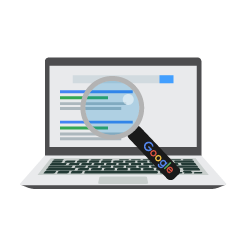As saving time becomes more of a priority for car buyers, many are turning to online car shopping to do so. According to Google, 92% of car buyers research their new vehicle online before purchasing. In that same study, Google also found that online purchasing has risen to 16% of total car sales. Insert vehicle listing ads.
So, how do this new ad format impact your dealership?
It means that vehicle listing ads will become increasingly more important for the success of your future. And to keep up with competition, you’ll want to implement Vehicle Listing ads, which come with unique benefits to bolster your online and in-store sales.
Vehicle listing ads were created to help expose your business to auto shoppers at the right moment, showing correct listings, and information that will expedite the buying process.

There are four key benefits that Vehicle Listing ads offer:
1. More Qualified Leads
It all starts with getting the right people to see your ads at the right time. Vehicle listing ads do this by showing customers important information and visuals about the car before they even click. This in turn creates more qualified leads since shoppers can see that information and decide if that listing is what they are searching for.
Examples of the information shown on Vehicle ads are as follow:
- Car Model/Make/Year
- Price
- Condition (New/Used)
- Mileage
- Dealer Name
You are able to target customers more precisely with this information. For example, say a customer searches, “Used 2014 Honda Accord,” your ad will be shown to that customer in your area with all the vehicle details. And because these ads are targeted for customers at the bottom of the funnel, the specificity of your ad draws in more qualified leads.
2. Omnichannel Goals
While the primary focus for vehicle listing ads is serving online customers, this doesn’t mean they exclude those still wishing to make purchases in-store. Vehicle listing ads give you the ability to optimize conversions for both online and offline customers. This creates more opportunities for your business to convert.
This omnichannel approach will allow for you to change and alter your strategy to suit your needs better. You can also pair this with smart-bidding so that your inventory can automatically adapt to consumers behaviors, which will help you maximize sales, online or in-store.
Having adaptability as such will get your listings in front of the right customers at the right time, making it more likely for them to convert and make a purchase. You can learn more about omnichannel strategies and how to best utilize them here.
3. Automated Targeting
If you’re already using display ads, then you will be familiar with automated targeting. Just as with display ads, vehicle listing ads will be shown to a similar audience to the one you specify. Relevant listings then populate for potential buyers searching similar keywords.
With this automation, you will have two options to choose from: conservative automation or aggressive automation. As their titles suggest, conservative automation will find potential customers based on your data history while staying at or under your cost per customer; aggressive automation on the other hand will target larger groups and potentially go above your cost per customer.
Which of these automations is right for you will depend on your needs and strategy. If you have a strict budget you want to stay under, then conservative automation should be your choice. If you are looking for higher conversions, aggressive automation will be in your favor. Although, there is a caveat with aggressive automation. Your campaign must have achieved more than 15 conversions per month to be active, according to MarketVantage.
Both options could be best suited for you and will guarantee that your vehicle listings are being shown to customers searching for similar or related terms or keywords. The main difference in performance will come down to the amount you are willing to spend.

4. Increased Exposure
All the previous features for vehicle listings lead to this last one – increased exposure. Increased exposure stems from vehicle listing ads being shown next to text ads on Google. This is a unique feature of vehicle listing ads.
The coupling of these two ad formats will function similarly to a brand-engagement campaign. Your vehicle listings will gain more interactions, build brand awareness, and motivate customers to engage, leading to more conversions, all due to this increased exposure.
As a car dealer this feature is crucial to take advantage of because vehicle listing ads not only serve as potential conversions but can be utilized as a method of driving more traffic and impressions to your website and dealership. Creating a strategy around your vehicle listing ads can be more than just a way to increase conversions.
Rules and Restrictions for Vehicle Listing Ads
You will have to follow a set of rules and requirements to ensure that your ads are compliant with Google. Following these rules is a must in order for your ads to run on Google.
According to Google, vehicle listing ads may be used to promote only non-commercial passenger vehicles, such as cars or pickup trucks (utes in AU). Recreational, commercial, farm, buses, 2-wheelers, trains, boats, airplanes, and outdoor utility vehicles are not permitted by Google.
Promoting vehicle parts, accessories, tires, or services is prohibited in this format. You are not allowed to run vehicle ads if you have any other Merchant Center programs, says Google. To see a full list of policies and requirements, visit here.
How Vehicle Listing Ads Work
Setting up vehicle listing ads on Google is a fairly straightforward process. First, you need to upload your vehicle data feed to the Merchant Center. The data uploaded here needs to contain relevant details about your vehicles such as make, model, price, mileage, and color. It’s important to include as many specific details as possible about your vehicles because Google uses this information to match customer searches with the most relevant vehicle.
Next, you will need to create a Smart Shopping campaign on Google. You will need to link your Google Ads account to a Merchant Center account and a Google Business profile. There are store feed alternatives for Business profiles if you are not the owner or manager of the dealership(s).
After doing that, you are all set and ready to launch your Vehicle ad campaigns. These ads will be targeting customers at the bottom of the funnel, meaning customers who are closer to selecting a specific vehicle, and will only appear on searches that have a high car shopping intent.
Vehicle ads are a great way for dealers to do many things, but mainly it will help increase your leads and exposure. Getting your vehicles in front of more qualified leads and customers will then lead to higher conversions for your dealership.
Start Working With Us Today
At J&L Marketing, we have digital marketing experts who will handle the entire process of strategizing, setting up, and optimizing your campaigns in Google. If you are a dealer looking to get more qualified leads, exposure, and increase your conversions, get in touch with us today! See how we can help you out-smart your competition and not out-spend them.



